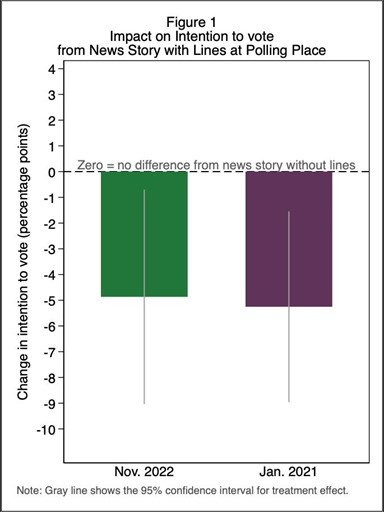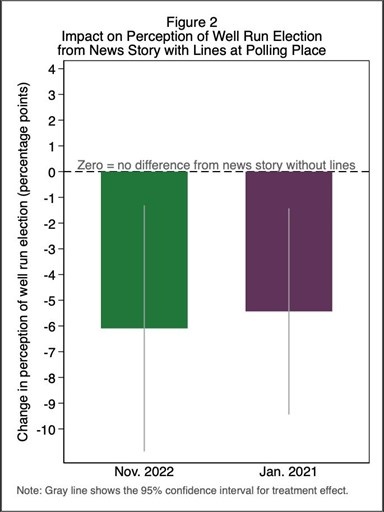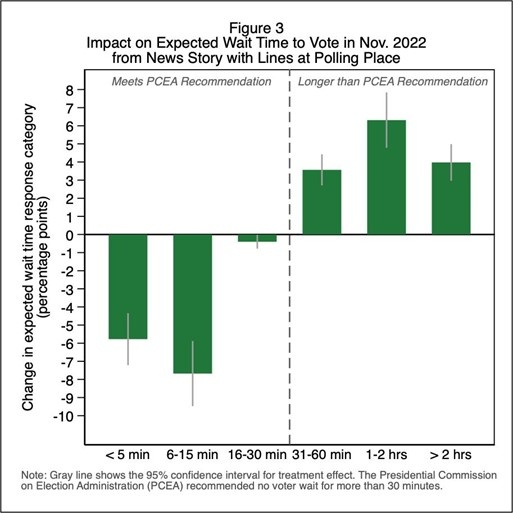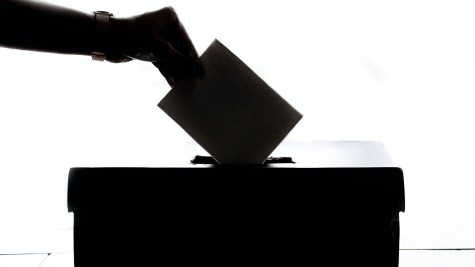News coverage that shows long voting lines may discourage people from voting
Updates from an ongoing study
The MIT Election Data and Science Lab helps highlight new research and interesting ideas in election science, including through research grants under our ongoing Learning from Elections program.
Our post today comes from Kathleen Searles and Christopher Mann, based on their ongoing research funded by this program. The information and opinions expressed in this column represent their own research, and do not necessarily represent the opinions of the MIT Election Lab or MIT.
When Election Day approaches, news outlets across the U.S. roll out their voting coverage: Candidates casting their ballots, “I Voted” stickers, election workers preparing polling places, and lines of eager voters.
It’s enough to inspire civic pride — but not all of these images are positive for democracy: Our research shows that people who watch a television news story that depicts polling place lines are less likely to vote in future elections.
Coverage of lines is prevalent, according to a content analysis we did of national and local news coverage leading up to the 2016, 2018, and 2020 elections. However, we found seeing lines in news coverage about voting made people think voting was more time-consuming, and decreased their confidence in elections.
The bipartisan Presidential Commission on Election Administration says that nobody should have to wait more than 30 minutes to vote. According to research by the MIT Election Data and Science Lab, the share of voters waiting more than 30 minutes declined from 16% in 2008 to 9% in 2016, when the average wait time was just 10.4 minutes. The trend reversed in 2020 due to Covid precautions at polling places and record-breaking turnout, with the average wait time rising back to 2008 levels: 14.3 minutes and 18% of voters’ waits exceeding the PCEA recommendation.
Our Research
While researchers have investigated the experience of waiting in lines to vote and the reasons for long lines at polling places, our work is the first to examine the effects of news that covers lines.
We conducted a series of survey experiments to measure the impact of news coverage of voting lines on the public’s attitudes about elections and voting behavior. In each experiment, we told participants they would see a short video of a local news story. The television news story featured a voiceover discussing early voting details and clips depicting common voting imagery, such as ballot boxes and poll workers. We created a second version of the story with one small difference: it also featured clips of people waiting in polling place lines. We then randomly assigned some participants to watch the story with lines, and another group watched the story without the lines clips.
After watching the clip, all participants answered questions on their intention to vote, their confidence in elections, and estimated wait times at their local polling place and nationally.
We fielded each experiment on a nationally representative sample of voting-age Americans (18+). The first experiment was conducted in January 2021, following the Georgia run-off for US Senate, and again in late October of 2022 to verify the results in the electoral context where people will encounter these stories. We focus on the two experiments that use a video treatment here for the sake of comparability, but we also conducted a third experiment that used a print news story where only the image, which either features a polling place line or people casting their ballots, was varied. The results are consistent across treatment modes, which suggests these effects are not limited to television news.
Americans who see news showing lines at polling places rather than elections running smoothly are significantly less likely to vote in future elections.
In both experiments, seeing the TV news story showing lines reduced the share of people saying they definitely plan to vote in the next election by 5 percentage points compared to seeing the story without lines.
Importantly, seeing news about lines at polling places has negative impacts on elections well beyond the polling place. After seeing stories about polling place lines, the share of people reporting elections were well run dropped by 6 percentage points in November 2022 and 5 percentage points in January 2021.
Consistent with prior research, the experiments also shed light on why news stories about lines decrease turnout: Voting is perceived as more time-consuming. Seeing a story about lines at polling places increased the share of people who expect wait times longer than 30 minutes in their community by 14 percentage points in November 2022 and by 11 percentage points in January 2021 – with many of these people expecting waits longer than 2 hours. These data suggest that journalists' choices about featuring lines in Election Day coverage can have serious consequences for turnout and attitudes about elections.
Caveats & Recommendations
Some caveats are in order. We do not follow up on whether people actually did vote, or whether their attitudes towards wait times and elections persisted. It is unlikely that one news story featuring images of lines is enough to cause lasting behavioral and attitudinal change. It is also possible that news audiences, rather than the public writ large, are politically interested enough and have enough knowledge of elections to deter any effects of such line coverage.
Still, our results are persistent across electoral contexts and types of coverage (television and print). They are also significant despite a relatively “weak” treatment of only varying the inclusion or absence of line images. Perhaps most importantly, these results also yield a practical recommendation that is relatively easy for newsrooms to implement: only show lines in news coverage if important to the story!









